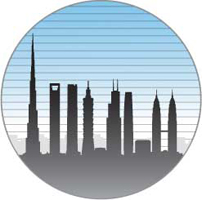
“Many people thought that 9/11 would be the death of tall buildings, but actually, what has happened in the last 10 years has been unprecedented in the number, size, and type of tall buildings that have been erected,” says Antony Wood, executive director of the IIT-based Council on Tall Buildings and Urban Habitat and a studio associate professor at IIT College of Architecture. “Almost every major city in the world has been developing tall buildings. That’s never happened before.”
As if to punctuate his statement, the Chicago firm of Adrian Smith + Gordon Gill Architecture announced in August that it is designing what will be the world’s next tallest building, Kingdom Tower, in Jeddah, Saudi Arabia. Smith also helped to design the current record-holder while he was at Skidmore, Owings & Merrill LLP-Burj Khalifa-in Dubai, United Arab Emirates, which opened in 2010. The Burj is as tall as Chicago’s John Hancock Center atop Willis Tower, the tallest building in the western hemisphere.
Wood transitioned into academia from his career as an architect on September 11, 2001. The day’s tragic circumstances inspired him to further his research on how tall buildings can relate to their unique environment and evolve to meet the challenges of the future, one being rapidly increasing urbanization.
“As a global species, we need to build a new city of a million people every week,” he says, citing United Nations statistics indicating that 200,000 people emigrate from rural to urban settings daily worldwide. One way to address this influx is to build vertically and maximize opportunities for social and commercial interaction through the use of horizontal connections-skybridges-between complexes that comprise multiple tall buildings. Skybridges can also provide an alternative escape route in the event of emergency.
“In normal usage, the skybridge enables sharing of space within the towers; in an emergency situation in one tower, the people in the top half don’t have to evacuate to the ground level but can exit halfway along into the safe tower and use the elevator there,” he explains.
Wood acknowledges, however, that even skybridges would not have made an appreciable difference in saving lives in a fuel-intensive and impact-heavy scenario like 9/11.
“When one looks at the extent of the trauma that the buildings experienced, it’s absolutely incredible that they stayed standing for a period of time at all,” he says. “So many lessons have been learned since then. 9/11 was projected into the conscience of people throughout the world like no other incident ever has. It focused much attention on the typology of tall buildings, which ultimately, has contributed to their success in the decade since then.”
Better Tall Buildings Post-9/11
Antony Wood says that since 9/11, tall building safety research has been focused primarily on three areas: improvements to structural systems, fire protection, and evacuation procedures. One change that has been occurring even before 9/11-substituting concrete-and-steel acting together compositely rather than steel alone as the primary building material-has improved other aspects of building performance.
“Concrete-encased steel gives better structural performance and solves the fire protection problem,” he says, noting that the gypsum-based fireproofing sprayed onto the interior supports of the World Trade Center came off when the planes struck the towers.
“When the fire occurred,” says Wood, “it weakened the exposed steel and ultimately, led to the collapse of the buildings.”

Some improvements include:
- Improvements to fireproofing material
- Occupant use of elevators in emergencies
- Glow-in-the-dark exit-pathway markers
- Improved automatic sprinklers
- Addition of third stairway and widening of stairways
- Concrete and concrete-encased steel
- Progressive-collapse redesign